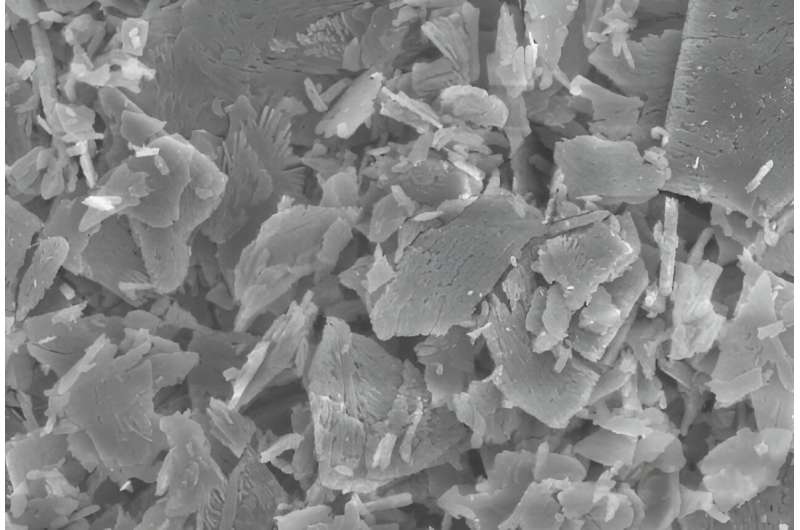This article has been reviewed according to Science X's editorial process and policies. Editors have highlighted the following attributes while ensuring the content's credibility:
fact-checked
peer-reviewed publication
trusted source
proofread
Biomaterial proves capable of accelerating bone regeneration

Researchers at São Paulo State University's Botucatu Institute of Biosciences (IBB-UNESP) in Brazil have developed a novel biomaterial that speeds up osteoblast (bone cell) differentiation. The invention has the potential to be used in the future in bone regeneration, bone grafting, and dental implant recovery, among other procedures.
As reported by the researchers in an article published in the Journal of Biomedical Materials Research, the material is cobalt-doped monetite, an important calcium phosphate compound with a similar structure to human bone mineral.
Monetite contains calcium, hydrogen, oxygen, and phosphorus. It has multiple biomedical applications, including coatings for prostheses and injectable bone cement. The researchers added cobalt, which plays a key role in osteoblast differentiation, as explained below.
"For the first time, our data produced sufficient evidence based on hypoxia that we may have a novel biomimetic material with the potential to regenerate bone tissue. The quantity and quality of autogenous bone available from the patient are not always sufficient for clinical grafting purposes," biochemist Willian Fernando Zambuzzi, a professor at IBB-UNESP and the last author of the article told us.
The grafting procedures currently deployed for patients with fractures or requiring tumor resection (removal), as well as dental prostheses, typically use bone fragments taken from the patients themselves but entail additional surgery to obtain the autogenous material, a risk of infection, and a longer convalescence.
Zambuzzi has researched bone biology since the early 2000s and is currently the thesis advisor for Ph.D. candidate Gerson Santos de Almeida, the first author of the article. He and his group have long specialized in investigating the molecules and mechanisms involved in bone development while also looking for compatible biomaterials.
Rising longevity in most countries around the world has led to an increase in research on bone regeneration and more effective related therapies. The research aims to help patients recuperate more quickly, shorten hospital stays, lower the cost of treatment, and avoid adverse side effects. Developing materials that can replicate the complexity of bone structure while also being safe and efficacious is evidently important in this context.
Knowledge construction
An article published in Nature in 2014 reported that endothelial cells (which line blood vessels) could stimulate osteoblast differentiation and that blood vessel growth and osteogenesis seemed to be coupled, with molecular crosstalk between endothelial and osteoblastic cells.
Based on these findings, Zambuzzi embarked on research of his own at the then-newly established Laboratory for Bioassays and Cell Dynamics. Seeking molecules that stimulated blood vessel growth with indirect effects on osteoblast differentiation, he eventually focused on cobalt chloride, which was known to promote hypoxia and lead the organism to increase the number of blood vessels in an effort to make up for the lack of oxygen.
"Hypoxia occurs naturally in tissue. Having explored its development and the links between endothelial cells and osteoblasts, we investigated biomimetic aspects and decided on artificial provocation of a novel molecule, cobalt-doped monetite, to stimulate bone production as a complementary effect to intensifying angiogenesis [creation of new blood vessels]," Zambuzzi said.
"Cytotoxicity testing based on the main biological evaluation standard for medical devices (ISO 10993:5) confirmed that the novel material is safe in this regard. The amount of cobalt was found to be a key factor in defining the ideal concentration for future biomedical applications, especially in the field of bone regeneration. "The basic research results were conclusive, giving us the go-ahead for a more complex analysis via preclinical models, including animal tests, to glean a better understanding of the translational aspects of the material," Zambuzzi said.
The group respects the three Rs: reduction of the number of animals used in tests, replacement of animals altogether wherever possible, and refinement to minimize animal discomfort. However, they see no way to avoid models that involve vertebrate physiology at some stage of product development.
"We're on the way to producing novel biomimetic materials that improve the quality of people's lives while complying with the strictest ethical principles in animal testing," he said.
More information: Gerson Santos de Almeida et al, Development of cobalt (Co)‐doped monetites for bone regeneration, Journal of Biomedical Materials Research Part B: Applied Biomaterials (2023). DOI: 10.1002/jbm.b.35319


















